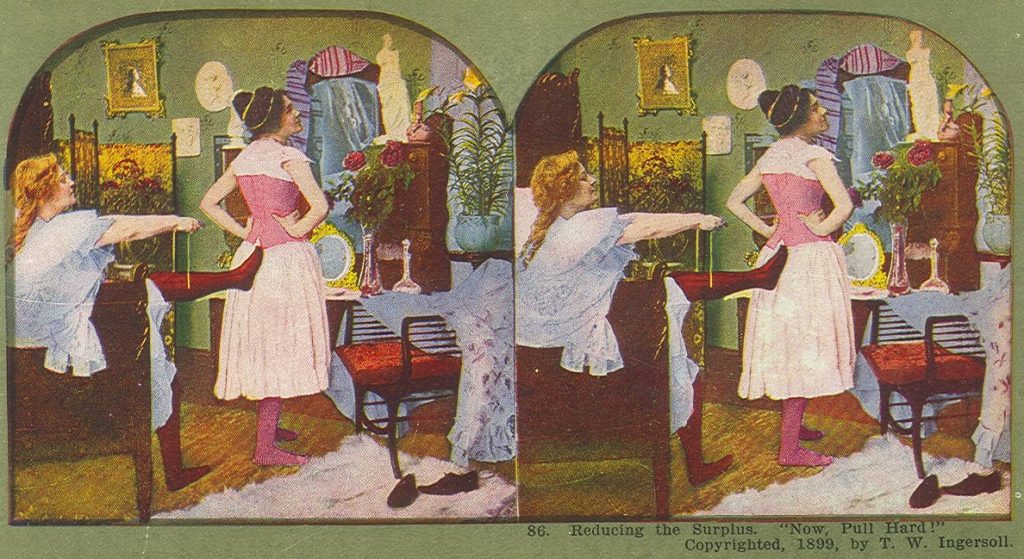
Sometime in my distant past, I was part of an education program about life in the Victorian era. We dressed in reproduction clothing and talked about life, culture and architecture around the turn of the century. One of the presentations I did was on how upper middle-class women dressed at that time. I would start with just my “unmentionables on” which were my split crotch drawers, a chemise that went down nearly to my knees and a partially laced corset. Under my drawers, I had on some thick tights since it was always cold in that room. I had a maid who dressed me while I talked to the guests. She tightened my corset, helped me put on my corset cover, then my petticoat, followed by a skirt then the matching bodice of my gown. I did this over and over again as groups came through at regular intervals.
In another part of the house (this was in a renovated historic home) other reenactors talked about courtship, running a household, local business, and the “fads” and “new innovations” of the day. Before we began to receive guests, I was called into the parlor by another reenactor who wanted to introduce me to his friend who was new to our merry band of history players. I was waiting for our first group to arrive so I was in my chemise, drawers, and corset. Since it was winter I had a long velvet shirt I brought that looked somewhat like a short dressing gown. It was not buttoned up in front so I could just throw it off when our visitors arrived. I was introduced to the new addition and we began talking about our day and what it’s like to speak in character in front of guests.
I began to notice the new recruit seemed to be avoiding my gaze. I have a tendency to look people in the eye when I talk but not in an aggressive way, just in a connecting way. His body language seemed to broadcast a bit of unease and he kept turning away and spending most of the time just looking at the other gentleman. Finally when I asked a question that required a long answer from him (not intentional since I wasn’t really sure what was going on) the oddest thing happened. When he turned to talk to me, he raised his hand and kept it outstretch as if I had a blinding light coming from me and he had to shield it. He then laughed nervously and said he just couldn’t talk to me dressed like that. It was very distracting and it felt wrong looking at me while I was undressed.
Undressed??
There was barely any naked flesh exposed. He could only see my face, my neck and a discreet portion of my chest as my chemise and corset did not expose any cleavage. From my neckline down I was completely covered in several layers including tights that were full-length modern tights, not the knee or thigh length stockings of the era, and shoes. Yet he couldn’t stop thinking of me as being undressed. Such is the power of suggestion. I’m technically in my underthings so I should be covered up. I laughed, and so did my more experienced colleague who had been doing theater and reenactment for so long he had seen women in many levels of undress that it no longer fazed him. The newbie found my corset, lace trimmed chemise, and ruffle hemmed knickers that went past my knees as unnerving as a bra and panties.
This is how sexuality in dress has worked for centuries. Ideas of modesty in dress have changed so much since we first took some hide and decided to cover up a portion of our bodies. It changes depending on the era, on location, on culture, on religion, on politics, on class, and our own desires to express ourselves through dress. In the past, there have been complaints that the farthingale was of the devil’s making and women used them to hide men. All this fuss over a cage that held the skirts out in a conical then later a barrel shape in the 16th and 17th centuries. Later people would satirize the flimsy lightweight regency gowns of the 1790’s as being too see through, low cut, and indiscreet. Yet we have cultures that had no problem with exposed breasts like the ancient Egyptians, the ancient Minoans, and several indigenous cultures that exist even today. Hemlines go up, necklines go down, and there is always someone who isn’t happy about it.
The fascinating thing about human’s preoccupation with the arrangements of material on our bodies is that neither the material nor the placement has anything to do with what is appropriate or modest. Our minds are the judge of what is acceptable according to what we have been told to believe is true at the time. In the 1950s, Dads couldn’t handle longhaired hippies who didn’t dress in the button down shirts and slacks they knew to be the way men dressed all their lives. People today lose their minds when men want to wear dresses or skirts because they are solely for women. Completely ignorant to the fact that men didn’t wear anything resembling pants for quite some time. Men have worn togas, chitons, loincloths, tight fitting hose, short poufed pumpkin breeches, ribbon loop bedecked satin breeches, and even just a gourd tied with string.
I remember my mom getting very upset when the mini skirt of the 60s decided to make a return in the mid 80’s. We had spent a period of time after the swinging sixties when maxi dresses, knee length skirts, and pantsuits were all the rage. The early 80s almost looked dowdy in its longish A-lined skirt that slowly became circle skirts as the 80s embraced the 50s look. Then suddenly the mini skirt was all the rage and hemlines continued to rise during the decade. I had lots of mini skirts back then. I even wore tank tops pulled down like a skirt. My parents were horrified. My dad didn’t like the fact that men were getting earrings and tattoos, either. To him only guys who were a little… you know… wore earrings (he couldn’t bring himself to say gay). It’s hard for him to think outside of his own time. Men wearing earrings goes back to ancient times and is not limited to gay men or jaunty pirates. But I could never get my parents to believe me.
Gender assigned clothing and colors and ideas of modesty in dress as always seen through the myopic lens of our own generation. But the history books, museums, historians, and anthropologists are there to remind us the all these things are fluid and evolving. The kids of today will look at their kids and think what they are wearing is ghastly and look back at their time with the haze of nostalgia. Unfortunately, these ideas also put rigid rules that can hurt. The idea of dress dictating whether a woman will get raped, that a man can be ostracized or beaten to death because he prefers women’s clothes. Kids forced to wear blue or pink when that idea has only been in existence for barely over a century. For millennia, we’ve had fashion amnesia. Perhaps someday we will evolve to become less concerned about the organization of materials on our bodies and more about what is under our skin.
Last modified: May 2, 2016


“Yet we have cultures that had no problem with exposed breasts like the ancient Egyptians, the ancient Minoans, and several indigenous cultures that exist even today.”
Oh yes. I may need to recheck my sources for an actual name because I can’t remember right now, but I’ve read that there’s a certain African tribe where unmarried girls have no problem baring their breasts, but their culture dictates that they cover their *faces* instead. I guess although “clothing covers ‘shameful regions'” is a valid theory, it’s. Ot without its exceptions because different people can view “shameful parts that need to covered” differently.
“The idea of dress dictating whether a woman will get raped, that a man can be ostracized or beaten to death because he prefers women’s clothes.”
I’ve read a lot of rather conflicting viewpoints on this matter. Slut-shaming happens a lot, true, but that’s mostly on the side of the ignorant, sexist bystander; what is your position on the stance that the police and prosecution when interviewing the alleged rape or assault victims have to (albeit calmly and neutrally) ask her or him what clothing they were weaing at the time of the incident, and whether or not they were under the influence of alcohol or drugs? Some people decry that as further victim blaming, but isn’t reconstructing the events to the best of a third party’s ability a very important part of the investigation? I’ve read cases when on relatively rare occasions the accusor was honest-to-God lying about the whole thing, and it showed in the investigation interviews. 😐
I believe that blaming the victim for their mode of dress is wrong. Thinking that someone is dressed in a way that is inviting sexually is actually a social construct. We need to change our collective mindset so that dressing in any way is not an invitation for sex, just a way for the individual to express themselves. Blaming the victim for the way they are dressed, or that they were under the influence, takes the responsibility away from the attacker and solely into the hands of the victim. IMHO
Yes, but do you agree that the police and prosecution asking about how he/she dressed during investigation and trial is in and of itself a part of victim-blaming? That’s the bit I couldn’t figure out.